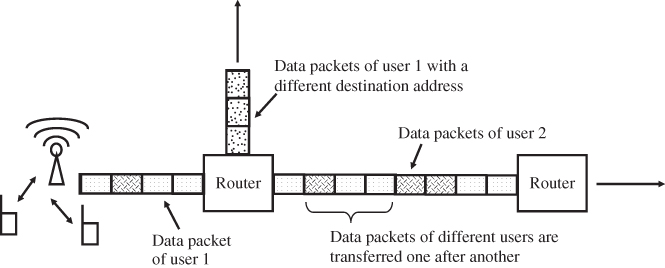2.2 Packet-Switched Data Transmission over GPRS
For bursty data applications, it would be far better to request for resources to send and receive data and release them again after the transmission, as shown in Figure 2.2. This can be done by collecting the data in packets before it is sent over the network. This method of sending data is called ‘packet switching’. As there is no longer a logical end-to-end connection, every packet has to contain a header. The header, for example, contains information about the sender (source address) and the receiver (destination address) of the packet. This information is used in the network to route the packets through the different network elements. In the Internet, for example, the source and destination addresses are the IP addresses of the sender and receiver.
Figure 2.2 Packet-switched data transmission.

To send packet-switched data over existing GSM networks, GPRS was designed as a packet-switched addition to the circuit-switched GSM network. It should be noted that IP packets can be sent over a circuit-switched GSM data connection as well. However, until they reach the Internet service provider they are transmitted in a circuit-switched channel and thus cannot take advantage of the benefits described below. GPRS, on the other hand, is an end-to-end packet-switched network and IP packets are sent packet switched from end-to-end.
The packet-switched ...
Get From GSM to LTE: An Introduction to Mobile Networks and Mobile Broadband now with the O’Reilly learning platform.
O’Reilly members experience books, live events, courses curated by job role, and more from O’Reilly and nearly 200 top publishers.

